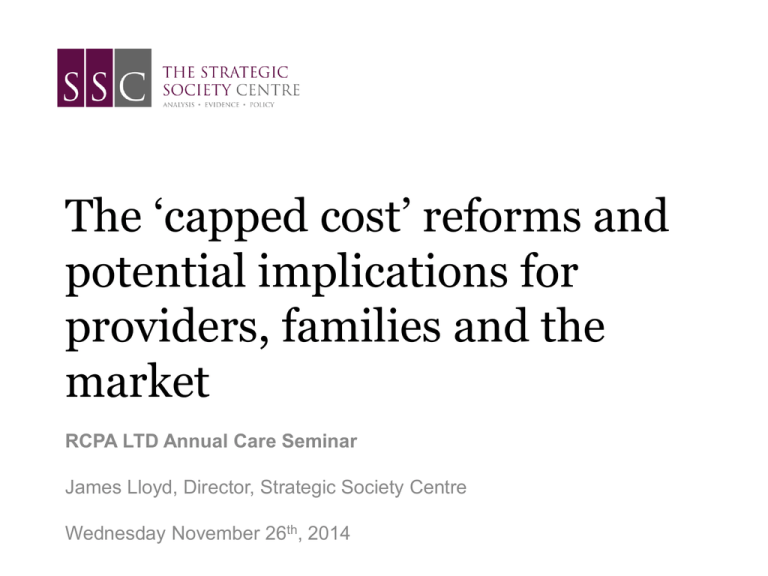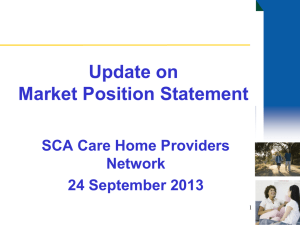Cap to Reality: The route to 2016 and care funding reform
advertisement

The ‘capped cost’ reforms and potential implications for providers, families and the market RCPA LTD Annual Care Seminar James Lloyd, Director, Strategic Society Centre Wednesday November 26th, 2014 Key messages Implementation of the Care Act could see significant changes to operation of residential care market in England Longstanding operating assumptions may be challenged Potential scenarios range from benign to scary DH now seeking to model potential impacts, but ‘muddling through’ likely to dominate LAs and providers may be on their own Providers need to think through scenarios and be prepared …Where are we now? England’s residential care market is already challenging environment Pressure on provider sustainability Especially in LA market Polarisation trend: providers exiting/not investing in poorer areas with fewer self-funders Variable link between price and quality Price discrimination by providers Different prices charged to different users Cross-subsidy from self-funders to LAs …So how does the Care Bill change the market? Key changes stem from ‘capped cost’ reforms to care funding Government accepted ‘Dilnot Commission’ proposals for ‘capped cost’ funding reforms in England All individuals with LA eligible needs will have their notional costs ‘metered’ via a Personal Budget and ‘Care Account’ In theory, all self-funders in residential care in England will have Care Account by April 2016 Key changes stem from ‘capped cost’ reforms to care funding As part of the reforms, the LA means test thresholds are being changed: Residential care: £17,000 and £118,000 However, until around February 2014, no one really thought through potential impacts on residential care market Key drivers of change in Care Bill… Price information + enhanced rights Universal knowledge of ‘local authority rate’ for residential care ‘New’ self-funders Far more people in residential care to receive some LA funding Likely extension of ‘3rd-party top-up’ rules to ‘new class’ of self-funders Public interest Enhanced public engagement with price of residential care …Price information Universal knowledge of ‘local authority rate’… By April 2016, ‘capped cost’ reforms will see all self-funders (c.125,000) in England given: Means and needs assessment Independent Personal Budget and ‘Care Account’ For first time, all self-funders + their families will know the LA ‘usual cost’ rate Result? Price discrimination + cross-subsidy in market will become far clearer Especially in ‘mixed’ care homes Potential scenarios… Disputes between families and care homes armed with knowledge of LA rate Attempts to renegotiate fee rates by selffunders and families Families requesting LA arrangement of care to access LA rate Although DH now questioning whether families will have this right Example… Imagine articles in 2016: 'I cut Mum's care home fees by £15,000 a year’… A Telegraph reader challenged her mother's care home and it agreed to cut its fees by £289 per week. Here is how you can do the same NB: these articles are already being published Potential scenarios… How will the market respond? Impact will depend on local circumstances, but we could see: Major challenge for providers in dealing with complaints/renegotiation? Providers less able to extract cross subsidy? Local authority rates increased to avoid provider failure? …Top-ups rules and ‘new’ selffunders ‘Top-ups’ in current market… 3rd-party top-ups have grown in use in English residential care market 175,000 self-funders 143,000 funded by local authority 56,000 individuals who ‘top-up’ the local authority funding they receive via ‘3rd-party payments’ Source: Laing & Buisson Some of the current rules on ‘topups’… A local authority’s ‘usual cost’ rate must always be adequate to procure appropriate accommodation in the local market A local authority’s ‘usual cost’ rate must not assume that top-ups are available If a local authority cannot procure appropriate care at its ‘usual cost’ rate, the council must pay the extra amount rather than seek top-ups from individuals or their family Local authorities should ensure that top-up arrangements are sustainable A local authority must never encourage a care home to seek top-ups from the family of an individual …However, rules are poorly applied ‘Capped cost’ reform changes… ‘Capped cost’ reforms will create new class of ‘self-funder’ top-up payers entitled to LA financial contribution: 1. Individuals reaching £72,000 ‘cap’ 2. Individuals below £118,000 higher Upper Capital Limit entitled to some LA contribution Estimated to be 35,000 existing residents in April 2016 ‘Capped cost’ reform changes… Duties and regulations set to be finalised However, likely that existing 3rd-party rules on ‘top-ups’ will apply to self-funder topups But, the impact on market of applying topup rules to this group is unclear… Example “If a local authority cannot procure appropriate care at its ‘usual cost’ rate, the council must pay the extra amount rather than seek top-ups from individuals or their family” How will this apply in April 2016 to existing resident becoming a ‘self-funder top-up’ who is unwilling to move? Will LA negotiate down rate? ‘Capped cost’ reform changes… Ultimately, applying top-up rules to this group may compel LAs to ensure ‘selffunder top-ups’ are not charged higher fees In effect, LAs may have to eliminate the cross-subsidy from the market on which they rely …Public interest Enhanced public engagement with price of care… 2015-16: major government PR campaign around ‘capped cost’ reforms Drive to raise awareness of changes Encouragement to ‘plan ahead’ Media coverage of “what it means for you” Enhanced public engagement with price of care… Multiple large media organisations planning engagement with issue Internet guides, e.g. Good Care Guide So, increasingly ‘savvy’ consumers coming into system? Upscaling of activity by consumer organisations Which?, Age UK, Independent Age Some may advise self-funders: “always ask the local authority to arrange your care as first step” And its impact?... New levels of transparency forced on market Public debate on price discrimination Can current ‘self-funder premium’ survive ‘court of public opinion’? If no, implications for providers, LAs and average rates? Key variable: Politics Price discrimination in care fees has potential to be front-page campaign for Mail, Telegraph, etc. So, clear risk of knee-jerk legislative response So bringing everything together… What will happen in 2016?... Changes in market could be slow/fast Difficult to predict Variation in market responses across country Emboldened, better-informed users and families: Wave of disputes? Impact on care homes? Price discrimination made unsustainable? Less cross-subsidy higher LA rates? What will happen in 2016? Continued polarisation of residential care market: Implications for investment/quality/capacity Growing public attention paid to how price of residential care is determined What will happen in 2016? Providers will explore range of ameliorating responses: Refusal of entry/long-term fee contracts for users worth less than £200,000? ‘Contrived differentiation’ within care homes to justify fee differences? Are care home staff prepared for this? On a positive note… Opportunity for policymakers, LAs and providers to completely rethink way in which price of care is determined Policymakers can try to cling on to crosssubsidy… … Or we can move toward open-book accounting, agreed rates of capital returns for providers, and fair prices paid by LAs But this could change the nature of the sector completely Strategic Society Centre 32-36 Loman Street London SE1 0EH strategicsociety.org.uk info@strategicsociety.org.uk @sscthinktank The Strategic Society Centre is a registered charity (No. 1144565) incorporated with limited liability in England and Wales (Company No. 7273418).








